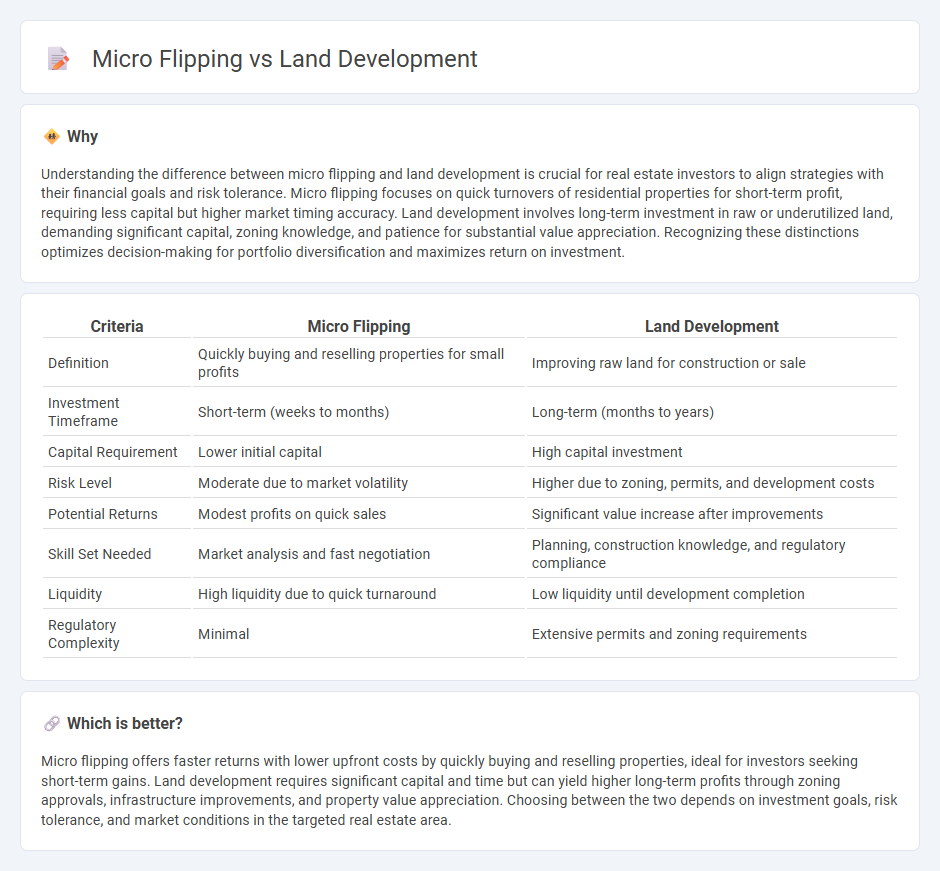
Micro flipping involves quickly buying, renovating, and reselling properties to generate fast profits, focusing on minimal holding time and lower investment compared to traditional methods. Land development requires acquiring raw land and improving it through zoning, infrastructure, and construction, demanding higher capital and longer timelines but offering substantial returns. Explore the benefits and challenges of each strategy to determine the best fit for your real estate investment goals.
Why it is important
Understanding the difference between micro flipping and land development is crucial for real estate investors to align strategies with their financial goals and risk tolerance. Micro flipping focuses on quick turnovers of residential properties for short-term profit, requiring less capital but higher market timing accuracy. Land development involves long-term investment in raw or underutilized land, demanding significant capital, zoning knowledge, and patience for substantial value appreciation. Recognizing these distinctions optimizes decision-making for portfolio diversification and maximizes return on investment.
Comparison Table
| Criteria | Micro Flipping | Land Development |
|---|---|---|
| Definition | Quickly buying and reselling properties for small profits | Improving raw land for construction or sale |
| Investment Timeframe | Short-term (weeks to months) | Long-term (months to years) |
| Capital Requirement | Lower initial capital | High capital investment |
| Risk Level | Moderate due to market volatility | Higher due to zoning, permits, and development costs |
| Potential Returns | Modest profits on quick sales | Significant value increase after improvements |
| Skill Set Needed | Market analysis and fast negotiation | Planning, construction knowledge, and regulatory compliance |
| Liquidity | High liquidity due to quick turnaround | Low liquidity until development completion |
| Regulatory Complexity | Minimal | Extensive permits and zoning requirements |
Which is better?
Micro flipping offers faster returns with lower upfront costs by quickly buying and reselling properties, ideal for investors seeking short-term gains. Land development requires significant capital and time but can yield higher long-term profits through zoning approvals, infrastructure improvements, and property value appreciation. Choosing between the two depends on investment goals, risk tolerance, and market conditions in the targeted real estate area.
Connection
Micro flipping involves rapidly buying and selling small properties or parcels of land, creating opportunities for strategic land development by identifying undervalued plots with potential for transformation. Land development enhances the value of these properties through zoning changes, infrastructure improvements, and construction planning, directly increasing market appeal and profitability. Both practices rely on market analysis, timing, and investment in property enhancements to maximize real estate returns efficiently.
Key Terms
**Land Development:**
Land development involves transforming raw or underutilized land into buildable plots by improving infrastructure like roads, utilities, and zoning compliance, thereby significantly increasing its market value. This process requires substantial capital investment, permits, and a longer timeline compared to quick resale strategies but yields higher long-term returns. Explore the key strategies and benefits of land development to maximize your real estate portfolio.
Zoning
Land development involves rezoning parcels to unlock higher-value uses such as residential, commercial, or industrial projects, requiring extensive planning and regulatory approvals. Micro flipping targets properties with existing favorable zoning, allowing quick resale without significant permitting challenges. Explore the nuances of zoning strategies to maximize returns in both approaches.
Entitlements
Land development involves obtaining entitlements such as zoning changes and permits to prepare raw land for construction, significantly increasing property value through regulatory approvals. Micro flipping focuses on rapidly acquiring and selling properties with existing entitlements, capitalizing on the immediate market value without extensive development. Explore more about how entitlements impact profitability in land development and micro flipping strategies.
Source and External Links
Land Development - The Basics (2023) - Transect - Land development is the process of altering a landscape following municipal and regulatory codes to meet community needs, including site assessment, design, planning approval, and construction.
Land development - Wikipedia - Land development involves changing landforms for uses like housing or agriculture, subdividing real estate, or repurposing buildings, with value influenced by planning and market factors.
What Are Stages of the Land Development Process? - The land development process includes purchasing suitable land, thorough planning and negotiation, design, and quality-controlled construction to create usable and profitable spaces.
 dowidth.com
dowidth.com